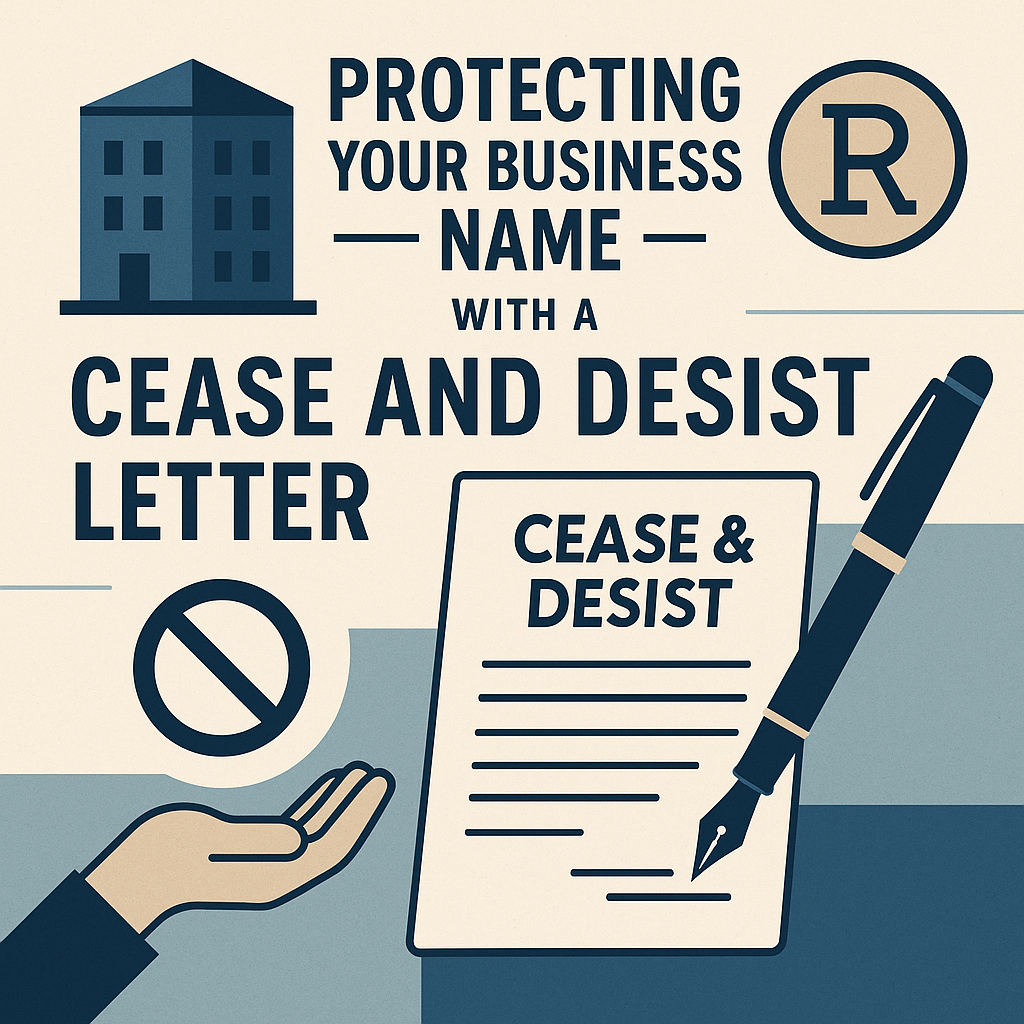Protecting Your Business Name with a Cease and Desist Letter
Safeguarding your business name is a critical step in protecting your brand, reputation, and future profits. Unfortunately, as your business gains visibility, you may encounter copycats attempting to ride on the success of your trademarks. A cease and desist letter can be an effective legal tool to stop infringers before more formal action is necessary.
This comprehensive guide will help you understand your common law trademark rights, the trademark registration process, and how Masterly Legal Solutions can help you enforce your rights confidently.
The Value of Your Business Name and Brand
Your brand name represents the trust and goodwill you have built with your customers. Whether you sell products or offer services, your business name and logo distinguish your goods or services from competitors in the market.
When another business uses a similar name, consumers may become confused, leading to lost revenue, damaged reputation, or both. In some cases, competitors intentionally mimic brand names to siphon off your customers.
Understanding Trademarks: Your First Line of Defense
Trademarks protect brand identifiers such as:
- Business names
- Logos
- Slogans
- Product names
These protections arise under common law, federal registration, and state laws. Even without a registered trademark, you can still assert common law trademark rights through continuous use in commerce.
Common Law Trademark Rights Explained
Common law trademark rights automatically begin when you start using your brand name or logo in connection with your products or services. While these rights can be strong, they are geographically limited.
With common law rights, you can:
- Send a cease and desist letter demanding the infringer stop using the mark
- Request damages if you suffer harm
- Ask a court to issue an injunction
However, proving the scope of these rights can be more challenging compared to a registered trademark.
The Benefits of Federal Trademark Registration
Registering your trademark with the United States Patent and Trademark Office (USPTO) provides significant advantages:
- Public notice of your ownership
- Nationwide protection
- Listing in the trademark office databases and the trademark official gazette
- The right to use the ® symbol
- Stronger enforcement tools
By completing the trademark registration process, you build a legal foundation that deters infringers and strengthens your claim in disputes.
How the Trademark Registration Process Works
The trademark registration process includes several steps:
- Comprehensive trademark search: A deep dive into the uspto database, state records, and common law search sources to spot conflicts.
- Filing your trademark application: Submitting the required forms, specimens, and filing fee to the patent and trademark office.
- Examination by an examining attorney: The USPTO reviews your trademark application for compliance and potential conflicts.
- Publication in the trademark official gazette: Allowing the public to oppose the application.
- Approval and registration: Issuance of your registered trademark certificate.
This registration process can take several months, depending on whether the USPTO issues an office action requiring additional information or clarification.
Trademark Application Mistakes to Avoid
Many business owners attempt to file without legal guidance, leading to:
- Rejection over a likelihood of confusion
- Final refusal for incomplete specimens
- Missed filing basis claims (such as intent-to-use vs. use-in-commerce)
- Additional fees due to mistakes
A seasoned trademark attorney helps you avoid these pitfalls and saves time and money in the long run.
The Role of a Cease and Desist Letter
A cease and desist letter formally demands the infringing party:
- Stop using your business name or mark
- Remove infringing logos from websites and marketing materials
- Refrain from future use
- Confirm compliance in writing
Sending a well-drafted letter demonstrates you take your trademark protection seriously. It also creates evidence you attempted to resolve the matter before resorting to litigation.
What Makes a Cease and Desist Letter Effective?
An effective letter should include:
- A clear description of your registered mark or common law rights
- Specific examples of the infringement
- A deadline to comply
- Notice of potential legal action
Careless or vague letters can backfire, so it’s critical to consult a knowledgeable trademark lawyer.
Masterly Legal Solutions: Your Partner in Enforcement
At Masterly Legal Solutions, our team provides:
- Strategic trademark search and clearance services
- Assistance with trademark application filings
- Guidance through office action responses
- Drafting and delivering persuasive cease and desist letters
- Representation in infringement disputes
Whether you are a startup, growing company, or established brand, our legal services are tailored to your needs.
Additional Enforcement Options
If a cease and desist letter doesn’t resolve the issue, you can consider:
- Filing a complaint with the USPTO for cancellation proceedings
- Pursuing federal litigation to seek injunctions and damages
- Exploring settlements that include payment of additional fees or rebranding
A well-executed enforcement strategy can help protect your market share and maintain your reputation.
The Importance of a Comprehensive Trademark Search
A comprehensive search uncovers:
- Similar marks registered at the trademark office
- Common law uses that could block your rights
- International filings if you plan to expand
This step is essential before you register a trademark or invest heavily in branding.
Foreign Registration and Global Protection
If you plan to sell internationally, consider foreign registration options to protect your mark abroad. Different countries have unique filing rules, and failing to act early can leave your brand exposed.
Costs and Considerations
While the trademark cost varies, the expenses of failing to protect your brand are often higher.
Typical costs may include:
- Government filing fees (varies by filing basis)
- Professional search services
- Trademark registration service fees
- Enforcement costs
We can help you estimate the total investment based on your situation.
The Role of the Examining Attorney
An examining attorney from the USPTO will review your application and issue an office action if problems arise. Responding properly is critical to keep your application moving forward.
Working with Masterly Legal Solutions
Our law firm is committed to helping small businesses, entrepreneurs, and established companies:
- File applications accurately
- Respond to objections
- Monitor the trademark office for potential conflicts
- Protect your business name and brand names
When Should You Send a Cease and Desist Letter?
You should act when you discover:
- Another company using a similar logo or trademark name
- Customers confused about your goods or services
- Online infringement or domain name misuse
Prompt action strengthens your claim and prevents further damage.
Common Myths About Trademark Registration
Some business owners believe:
- Registration is automatic—it isn’t.
- A basic package from a trademark engine guarantees success—it doesn’t.
- You only need to register in one state—federal protection is broader.
A trademark professional helps you separate fact from fiction.
The Importance of Trademark Maintenance
After you register, you must:
- Use the mark continuously
- File periodic renewals
- Monitor for infringement
Neglecting these steps can weaken your rights.
Your Next Steps to Protect Your Business Name
If you believe your trademarks are being copied:
- Gather evidence of the infringement
- Document the impact on your business
- Contact an experienced trademark attorney to draft a cease and desist letter
How Masterly Legal Solutions Can Help
We offer:
- Trademark search and clearance
- Customized cease and desist letters
- Enforcement strategies
- Filing and monitoring of applications
- Guidance on foreign registration
Our team combines practical business insight with deep legal experience.

How Trademark Owners Can Leverage a Cease and Desist Letter to Safeguard Intellectual Property
Trademark owners who want to defend their brand identity often begin by filing with the Trademark Center, which oversees the trademark filing and application process through the USPTO. While the filing process may seem straightforward, even a standard package can involve detailed requirements—especially if your brand includes a unique sound mark or distinctive logo.
Once your mark is approved, you gain stronger rights to act against infringement. If you discover unauthorized use, a carefully drafted cease and desist letter can be an effective tool to enforce your intellectual property without immediately turning to litigation. In some cases, disputes escalate to legal action, as seen in decisions from the Arizona Supreme Court, which has addressed complex conflicts over business names and trademarks. Remember that USPTO charges and filing fees can vary, and publications like Forbes Advisor often recommend consulting experienced professionals to ensure your rights are fully protected. Always include your business’s official address in the letter to demonstrate legitimacy and establish a clear record of communication.
What Happens After Your Trademark Is Approved by the USPTO
Once your trademark application is approved by the USPTO, you gain powerful legal tools to protect your brand and business name. An approved registration provides nationwide rights, making it much easier to stop competitors from using similar marks for related goods or services. With this formal recognition, your cease and desist letters carry far more weight, often compelling infringers to comply without the need for litigation.
Remember, even after your mark is approved, you must continue using it in commerce and monitor the market for unauthorized use to maintain strong protection. Regular enforcement efforts ensure your brand stays secure and recognizable in a crowded marketplace.
The Importance of a Comprehensive Search Before Sending a Cease and Desist Letter
Before you send a cease and desist letter, it is critical to conduct a comprehensive search to confirm that you have clear priority rights to the trademark in question. A professional comprehensive search goes beyond a quick glance at the USPTO database and reviews state filings, domain names, business directories, and other common law uses that could impact your claim.
If you skip this step, you risk asserting rights you don’t fully own, which can backfire legally and damage your credibility. Working with a knowledgeable trademark attorney ensures your comprehensive search is thorough, giving you the evidence you need to confidently enforce your brand and protect your business name.
Why Small Businesses Should Work with a Trademark Attorney to Protect Goods or Services
Many small businesses underestimate the importance of partnering with a qualified trademark attorney when navigating the application process to register a trademark with the Patent and Trademark Office. The trademark center requires applicants to select an appropriate filing basis, accurately describe their goods or services, and pay the applicable trademark cost.
If your submission is incomplete or conflicts with an existing registration, you may receive an office action, delaying approval or putting your rights at risk. A trademark professional can help you prepare strong documentation and respond effectively to any objections, increasing the likelihood that your brand will be protected nationwide. By investing in legal support early, you create a solid foundation to enforce your trademark—whether through negotiation or by sending a cease and desist letter to stop infringement before it harms your business.
When and How to Submit Your Trademark Application to Protect Your Brand
To secure the strongest legal footing before sending a cease and desist letter, you should submit your trademark application to the USPTO as early as possible. When you submit your filing, it formally begins the examination process, establishing a public record of your claim to the business name and logo you use in connection with your goods or services.
Many small businesses mistakenly delay this step, which can weaken their position if an infringement dispute arises. By working with a skilled trademark attorney, you can ensure that all required documents, specimens, and declarations are properly prepared before you submit your application. Prompt filing not only protects your rights but also strengthens your ability to enforce them confidently when infringement occurs.
Take Action to Defend Your Brand
Don’t let copycats erode the goodwill you’ve worked so hard to build. Protect your business name, your reputation, and your profits with decisive action.
Ready to Safeguard Your Business Name?
Contact Masterly Legal Solutions today at (972) 236-5051 for a free consultation. We’ll help you understand your rights, explore your options, and develop a plan to protect your brand with confidence. Whether you need assistance drafting a powerful cease and desist letter, navigating the trademark registration process, or enforcing your rights, our attorneys are here to guide you every step of the way.
Notice: This post is not legal advice; it is merely informational in nature. For advice tailored to your circumstances, please speak with an attorney.
Looking for Legal & Business Solutions? Contact Us Now
Fill in the form or call us to set up a meeting














